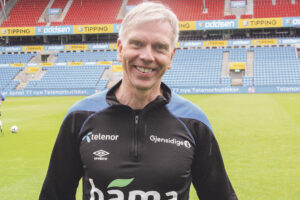Lena Kristin Bache-Mathiesen, Thor Einar Andersen, Torstein Dalen-Lorentsen, Benjamin Clarsen, Morten Wang Fagerland. Not straightforward: modelling non-linearity in training load and injury research.
The full paper can be found here





Tell us more about yourself and the author team.
I am a PhD student at the Oslo Sports Trauma Research Centre (OSTRC) at the Norwegian School of Sport Sciences, having a background as a statistician at Haukeland University Hospital. The OSTRC aims to prevent injuries and health problems in sports through developing and implementing preventive programs and measures. The centre focuses on the most impactful injury types in the biggest Norwegian sports; football, handball, and skiing.
Thor Einar Andersen and Morten Wang Fagerland have supervised this project. Thor Einar Andersen is a consultant sports medicine physician and a consultant in Physical Medicine and Rehabilitation and is the medical director at the Norwegian FA Medical Clinic in Oslo. He also holds a position as a professor at the OSTRC. He provided valuable insight into clinical and sports-related aspects and improved the readability of the paper considerably. Morten Wang Fagerland is an associate professor in biostatistics at the OSTRC and heads the Section for Biostatistics and Epidemiology at the Oslo University Hospital. He validated the statistics applied in the study and provided guidance for the methodological choices.
Co-author Benjamin Clarsen is a sports physiotherapist and scientist who has published extensive research on overuse injuries in sports. At the same time, Torstein Dalen-Lorentsen is a PhD student at the OSTRC, with a master’s in sports physiology and expertise in measuring and studying training load and its relation to sports injuries. Their insight has been invaluable in the design of the study design and in writing the paper.
What is the story behind your study?
It started with a discussion on how to model training load in sports as a continuous variable. The team had recently performed a study showing the pitfalls of categorizing training load measures, but we weren’t sure what the alternatives were and what would be the best option. Furthermore, we desired to explore, learn new methods, and provide researchers with improved statistical tools.
The problem was that training load is considered to have a non-linear relationship with injury risk, which is why researchers have categorized it in the first place. This makes it more challenging to model training load as a continuous variable. The focus of the study became how to handle non-linearity while simultaneously being able to model training load as a continuous variable.
Several hypotheses about the relationship between training load and injury risk have circulated in this field, many suggesting it’s non-linear. We realized that few studies had attempted to test these hypotheses by checking whether the relationship is, in fact, non-linear. What if the relationship is linear, and handling nonlinearity isn’t so important? That’s why we added another aim to the study: to search for potential non-linearity between training load and injury risk in different sports.
In your own words, what did you find?
We discovered signs of non-linearity between training load and injury risk in the sports cohorts, emphasising the need to handle non-linearity in future research. We also found that fractional polynomials and restricted cubic splines were the best options to discover and model non-linear relationships.
We were taken by surprise that categorization did not just perform poorly when accounting for non-linearity. It was also unable to model the conventional, linear shape.
What was the main challenge you faced in your study?
The biggest challenge was to write an article for a study heavily focused on methodology while keeping the methods and result sections succinct, digestible, and within a reasonable word count. We wanted to catch the interest of clinicians and sports scientists who don’t necessarily have a sound background in statistics but who wish to learn about and apply improved methods in their research. At the same time, we wanted to ensure enough information for reproducibility and clarity for readers with a special interest in methodology. Writing the article became a balancing act between “too much” and “too little” information, and we settled on having a supplementary methods section for those interested in the details.
If there is one take-home message from your study, what would that be?
Use methods to explore the potential for non-linearity!